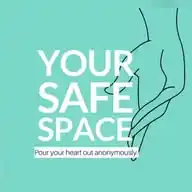
Nigerian Youths Living With Personality Disorders
7 subscribers
About Nigerian Youths Living With Personality Disorders
This is a safe space for Nigerian youths living with mental health challenges like ADHD, Bipolar Disorder, Borderline Personality, and more. Here, you can share your thoughts anonymously without judgment. I’m not a professional—just someone learning and growing alongside you. Let’s break stigmas, lighten the load, and maybe even laugh a little along the way. Welcome to the fam! 💙
Similar Channels
Swipe to see more
Posts

🌟 Breaking the Stigma Around BPD 🌟 Hello, amazing people! Yesterday, we yarn about treatment options for Borderline Personality Disorder (BPD). Today, we’re shifting gears to address a very important topic: breaking the stigma around BPD. Stigma dey make life harder for people living with BPD, and it’s time we change the narrative! 💪 --- 1. Stigma No Be Help – It’s a Barrier Many people think BPD means someone is “difficult” or “manipulative.” This na wrong mindset! People living with BPD dey already struggle with their emotions; adding judgment only makes things worse. --- 2. Educate Yourself – Knowledge Na Power Learn the facts about BPD. Understand say na brain chemistry and life experiences dey cause the condition, no be personal choice. When you hear someone say something wrong about BPD, gently correct them with facts. --- 3. Use Positive Language – Words Matter Avoid terms like “crazy” or “toxic.” People with BPD no be their diagnosis; dem be humans with feelings, struggles, and strengths. Instead, focus on their resilience and creativity. --- 4. Normalize Seeking Help – Therapy No Be Weakness Encourage open conversations about mental health. Make we talk about therapy and treatment like how we dey talk about gym or doctor visits. E no suppose carry shame. --- 5. Share Stories of Hope – Inspire Change Share stories of people living fulfilling lives with BPD. Remind the world say with treatment and support, thriving with BPD is very possible! --- 6. Be Kind and Patient – Empathy Na Key Understand say people with BPD no choose their struggles. What they need most na love and understanding. A little kindness fit go a long way in helping someone feel accepted. PS: Tomorrow, we’ll dive into myths about BPD and bust some of the biggest misconceptions. You won’t want to miss it! 😊 Together, let’s make mental health conversations normal and stigma-free. Much love, Your Ever-Passionate Admin ❤️

🌹 Happy Valentine’s Day, Amazing People! 🌹 Hello, my beautiful audience! Today na the day of love, and I just want to remind you that you’re deeply appreciated. Whether you’re spending the day with loved ones, friends, or enjoying some quality "me-time," remember say love starts with YOU. ❤️ 3 Quick Reminders This Valentine’s Day: 1️⃣ You Are Enough – No matter what, you’re deserving of love and care, just as you are. 2️⃣ Celebrate All Kinds of Love – Romantic love is sweet, but let’s not forget self-love, friendship, and family love. They’re equally powerful! 3️⃣ Take a Moment for Yourself – Treat yourself to something nice today, whether it’s your favorite snack, a good book, or just some quiet reflection time. Sending all the positive vibes your way today and every day! 🌟 Let’s keep spreading love and kindness—not just today, but always. Much love, Your Ever-Caring Admin ❤️

🌟 Let’s Talk About the Symptoms of Borderline Personality Disorder (BPD) 🌟 Hello, wonderful people! As we dive into this week’s focus on Borderline Personality Disorder (BPD), today we dey break down the symptoms of this complex and often misunderstood condition. Understanding the symptoms fit help us better empathize with those living with BPD. Let’s get into it! --- 1. Intense Fear of Abandonment People with BPD fit go extra lengths to avoid real or imagined abandonment. E fit manifest as clinginess or pushing people away to “test” their loyalty. --- 2. Unstable Relationships Relationships with loved ones fit dey intense and full of ups and downs. People with BPD often see others as either “all good” or “all bad,” switching quickly between the two. --- 3. Unclear or Shifting Self-Image The sense of self fit dey unstable. People with BPD fit feel like dem no sabi who dem really be. E fit lead to frequent changes in goals, values, or identity. --- 4. Impulsive Behaviors Risky behaviors like reckless spending, unsafe sex, substance abuse, or binge eating fit happen. These behaviors often dey fueled by trying to escape emotional pain. --- 5. Intense Emotional Swings Mood changes dey happen quickly, lasting a few hours to a few days. Emotions fit go from extreme happiness to deep sadness or anger without warning. --- 6. Chronic Feelings of Emptiness Many people with BPD dey describe feeling hollow or empty inside. This feeling fit lead to restlessness or attempts to fill the void in unhealthy ways. --- 7. Explosive Anger Intense, inappropriate anger or difficulty controlling anger fit be common. E fit lead to verbal outbursts or physical aggression, even over small matters. --- 8. Self-Harm or Suicidal Behaviors Self-injury (like cutting) or frequent suicidal thoughts or attempts fit occur. These behaviors often dey tied to overwhelming emotional pain. --- 9. Paranoia or Dissociation During stressful times, people with BPD fit feel paranoid or disconnected from reality (dissociation). E fit feel like an “out-of-body” experience or being detached from emotions. --- Key Takeaway: Living with BPD no easy, and the symptoms fit vary from person to person. If you or someone you know dey experience these symptoms, professional help dey available, and there’s hope for better days. PS: Tomorrow, we go talk about how to cope with BPD, whether na you get am or you dey support someone who does. Stay tuned! 😊 Cheers, Your Ever-Jovial Admin ❤️

🌟 Treatment Options for BPD – Let’s Talk Solutions! 🌟 Hello, wonderful people! Yesterday, we discussed ways to cope with BPD, but today we’re diving into treatment options—because managing BPD is very possible with the right support and tools. 💪 --- 1. Therapy – The Foundation of Healing Dialectical Behavioral Therapy (DBT): Designed specifically for BPD, DBT teaches skills like emotional regulation, mindfulness, and coping with stress. Cognitive Behavioral Therapy (CBT): Helps identify and change negative thought patterns and behaviors. Schema-Focused Therapy: Works on changing unhelpful beliefs formed during early life. --- 2. Medication – Balancing Brain Chemistry While there’s no specific “cure” medication for BPD, doctors may prescribe meds to manage certain symptoms like: Mood stabilizers (to reduce mood swings). Antidepressants (to ease depression and anxiety). Antipsychotics (for intense mood or thought disturbances). Medication works best alongside therapy—always consult a professional before starting or stopping meds! --- 3. Hospitalization – For Crisis Situations In cases of severe emotional distress or self-harm, temporary hospitalization may provide a safe space to stabilize and regroup. --- 4. Support Groups – Strength in Numbers Connecting with others who understand your experience can be incredibly empowering. Sharing stories and strategies creates a sense of belonging and hope. --- 5. Self-Care – A Daily Practice Regular exercise, healthy eating, and proper sleep improve mental health. Explore mindfulness techniques like yoga, meditation, or journaling to stay grounded. --- Final Thoughts: Treatment for BPD na journey, not a sprint. What works for one person fit no work for another, and that’s okay. Patience, persistence, and professional guidance are key. PS: Tomorrow, we’ll be talking about breaking the stigma around BPD and why it’s so important. Don’t miss it! 😊 Stay kind to yourself and others, Your Ever-Caring Admin ❤️

When it comes to the symptoms of Borderline Personality Disorder (BPD) we discussed, how many resonate with you or someone you know?

🌟 We’re Back! Let’s Talk About Borderline Personality Disorder (BPD) 🌟 Hello, my amazing people! First off, I wan thank every single one of you for bearing with me during my short hiatus last week. Your understanding and support dey mean the world to me! ❤️ Now that we’re back in full swing, this week we go focus on Borderline Personality Disorder (BPD). We go explore: 🔹 The Symptoms – Wetin to look out for. 🔹 How to Cope – For those living with BPD and their loved ones. 🔹 Treatment Options – Professional care and self-help strategies. 🔹 Breaking the Stigma – Because everyone deserves respect and understanding. It’s going to be an eye-opening and impactful week as we learn together. Stay tuned for updates, insights, and maybe some fun activities along the way! Cheers, Your Ever-Jovial Admin 😊

https://docs.google.com/forms/d/e/1FAIpQLSe_Rw1tDL_QGgQagA-UE-b9WOUU1OwRC4wXUJL4X5SZ1QBAAw/viewform?usp=sharing

🌟 The Different Types of Bipolar Disorder 🌟 Hello, amazing people! Yesterday, we yarn about how people fit thrive with Bipolar Disorder. Today, as promised, we dey break down the different types of Bipolar Disorder and how dem dey manifest. Because understanding the types fit help us support ourselves and loved ones better. Let’s dive in! 🌊 --- 1. Bipolar I Disorder – The Big Highs and Lows: This one dey characterized by extreme manic episodes wey fit last at least a week. Depression episodes dey follow the mania, and sometimes the person fit need hospitalization during the manic phase. Think of Bipolar I like a high-speed rollercoaster. 🎢 --- 2. Bipolar II Disorder – The Softer Waves: For this type, the person dey experience hypomania (a milder form of mania) instead of full-blown manic episodes. Depressive episodes dey more frequent and intense than the hypomanic episodes. Na like a smaller, gentler rollercoaster but still with its ups and downs. --- 3. Cyclothymic Disorder – The Long Game: This one dey involve milder mood swings wey dey last for at least two years (or one year for children and teens). The mood changes no reach the level of full mania, hypomania, or depression, but dem still dey noticeable. Imagine a wave wey no too high or low, but e dey constant. 🌊 --- 4. Bipolar with Mixed Features – A Complex Combo: This one dey happen when symptoms of mania/hypomania and depression overlap. Imagine feeling high energy but also sad and hopeless at the same time—confusing, abi? --- 5. Rapid Cycling – The Fast Lane: When a person experience four or more mood episodes (mania, hypomania, or depression) within a year, dem fit call am rapid cycling. E dey happen for both Bipolar I and Bipolar II. --- Key Takeaway: No matter the type, Bipolar Disorder na unique experience for everyone. Diagnosis and treatment from professionals na the best way to manage am effectively. --- Fun Activity – Let’s Learn Together! 🎉 Which of these types surprise you the most? Or which one you don hear about before now? Share your thoughts, and let’s keep the conversation flowing! PS: Tomorrow, we go wrap up the week by talking about personal stories of thriving with Bipolar Disorder and answering your top questions. Don’t miss am! 😊

🌟 A Quick Note from Your Admin 🌟 Hello, my amazing people. I just wan drop small update—this week, there won’t be any new posts on the channel. As much as I love connecting with you and sharing knowledge, I need to take a step back to focus on my own mental health. We all know say mental health dey important, and sometimes, even those wey dey encourage others need time to refill their own cups. Please bear with me as I take this time to recharge. Thank you for being such a spectacular and understanding audience. Your support means the world to me, and I promise we’ll continue our incredible conversations soon. Until then, please take care of yourselves and each other. ❤️ Cheers, Your Grateful Admin 🙏

🌟 How to Cope with Borderline Personality Disorder (BPD) 🌟 Hello, amazing people! Previously, we yarn about the symptoms of BPD, but today we dey focus on how to cope with it—whether na you get BPD or you dey support someone living with it. With the right tools and support, life fit dey easier and more fulfilling. Let’s dive in! --- 1. Seek Professional Help – Therapy Is Key Dialectical Behavioral Therapy (DBT): E dey specially designed for BPD and fit teach skills like emotional regulation, mindfulness, and coping strategies. Cognitive Behavioral Therapy (CBT): E fit help you change negative thought patterns. No be shame to see a therapist or psychiatrist. Treatment dey work! --- 2. Build a Routine – Create Stability Regular sleep, balanced diet, and consistent daily activities fit help reduce mood swings. Use planners, alarms, or apps to stay organized. Small routines dey create big peace. --- 3. Practice Mindfulness – Stay in the Moment Mindfulness dey help you focus on the “now” instead of past regrets or future worries. Try deep breathing, meditation, or grounding techniques when emotions dey overwhelm. --- 4. Identify and Avoid Triggers Pay attention to wetin dey cause mood swings or impulsive behaviors—e fit be stress, conflict, or even certain environments. Once you identify triggers, work on ways to reduce or manage dem. --- 5. Build a Support Network – You No Dey Alone Surround yourself with people wey care about you and understand your journey. Join support groups (online or in person) to connect with others living with BPD. --- 6. Practice Self-Compassion – Be Kind to Yourself No beat yourself up when things go wrong. You dey try, and that na enough. Celebrate small victories, and remind yourself say progress no be straight line. --- 7. Develop Healthy Coping Mechanisms Instead of impulsive behaviors, try: 🔹 Journaling your feelings. 🔹 Drawing, painting, or any creative outlet. 🎨 🔹 Taking a walk or doing physical exercise. 🏃♂️ --- 8. Learn Communication Skills When emotions dey high, take a moment to breathe before you respond. Learn how to express your feelings without blame. E dey help relationships grow stronger. --- Key Takeaway: Living with BPD fit be challenging, but with proper care, self-awareness, and support, you fit thrive. Remember: You no be your diagnosis; you be strong, resilient, and capable of living a fulfilling life. --- Fun Activity – Let’s Share! 🎉 What’s one healthy coping mechanism wey you or someone you know dey use when emotions feel overwhelming? Share with us, and let’s inspire each other! PS: Tomorrow, we go yarn about treatment options for BPD, including therapies and medications. Stay tuned, my people! 😊 Cheers, Your Ever-Jovial Admin ❤️












